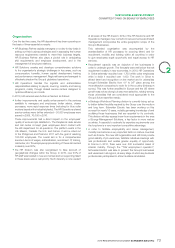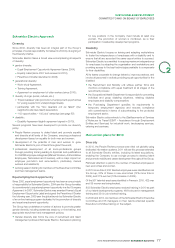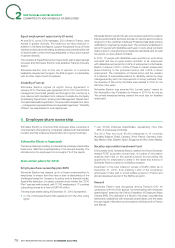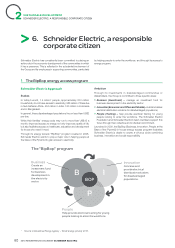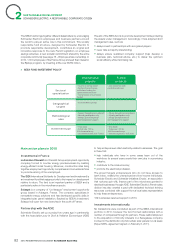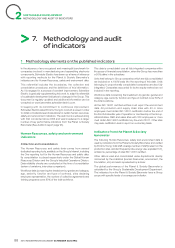APC 2010 Annual Report Download - page 85
Download and view the complete annual report
Please find page 85 of the 2010 APC annual report below. You can navigate through the pages in the report by either clicking on the pages listed below, or by using the keyword search tool below to find specific information within the annual report.
SUSTAINABLE DEVELOPMENT
SCHNEIDER ELECTRIC, ARESPONSIBLE CORPORATECITIZEN
Offers and economic models for the base of
the pyramid (Innovation)
Innovation is refl ected in the design and deployment of electricity
distribution solutions for disadvantaged groups.
Approach
Innovation for Schneider Electric starts with the local needs and the
socio-economic context of those with little or no access to electricity.
With this in mind, the chief aims of its offers and economic models
are to:
•meet the energy needs of residents to support sustainable
economic and social activity;
•include and involve local populations in projects to guarantee
their sustainability in the long term.
Schneider Electric sets out to provide comprehensive energy access
solutions that support revenue-generating entrepreneurial activities,
foster community services or meet domestic needs. Products and
solutions are developed to meet a range of both individual and
community needs across the energy chain, from lighting systems
and battery charging stations to decentralised small power plants
and water pumping systems.
Main achievements in 2010
Electrification of villages in Tanzania,
Cambodia and Vietnam
After Madagascar in 2009, three similar projects were successfully
initiated in 2010.
The fi rst two, in Tanzania and Cambodia, are exact replicas of the
system installed in Madagascar. They were established in partnership
with training institutes invested in by Schneider Electric to provide
electrical skills training in disadvantaged population groups.
In Vietnam, a decentralised, hybrid micro-grid brought electricity to
Village 61. 35 households (151 inhabitants) and a border post benefi t
from this installation.
Launch of a collaborative project
The MiCST project consists of designing and manufacturing
an innovative solar plant using sunlight to heat a thermal energy
supply powering a thermodynamic machine coupled with a 10-kW
alternator. The solution will be designed to supply off-grid areas.
MiCST is aimed in particular at developing countries with strong
sunlight. Simple to install and maintain, it can be easily adopted by
local populations. A major technical and technological challenge,
it will take high-strength, low-cost and eco-design criteria into
consideration.
The project extends over 42months and coordinates the expertise
of 12 industrial and research partners. It is supported by the French
Environment and Energy Management Agency (ADEME).
Low-consumption lighting system
In a program to extend access to energy, lighting is one of the fi rst
vital needs expressed by population groups denied access or reliable
access to electricity. Lighting makes it possible to study after the
sun has gone down and to extend entrepreneurial activities into the
evening. Schneider Electric developed In-Diya, an innovative and very
low-cost domestic lighting system With two types of lamp made up
of 90 or 45 low-consumption LEDs (4.5W for 90 LED) that can be
connected to a battery, which is in turn connected to a photovoltaic
panel for charging.
This new system is now available practically everywhere in the
world. Partnerships have been set up with local institutions and
organisations to optimise deployment of the product and to target
the poorest communities.
The lamps are sold through our distribution networks, subsidiaries,
a number of NGOs and businesses in the sector developing access
to electricity.
Training (People)
Approach
The key challenge of training in the electrical sector is to provide
those at the “base of the pyramid” with the skills and know-how
to be able to sell and maintain energy access services and, in time,
to set up their own businesses. Without local skills there can be no
sustainable development.
Schneider Electric’s strategy for the training of disadvantaged groups
at the base of the pyramid includes three key priorities:
•relatively short, undemanding and widely accessible basic
training;
•training leading to qualifi cations in partnership with local Ministries
of Education;
•training for trainers to support effective and quality roll-out of
training down the line.
Training is funded by the Schneider Electric Foundation and is always
deployed in partnership with local and national or international
organisations (NGOs, government, etc.).
Main action plans in 2010
2010 saw the acceleration of our training drive by intensifying existing
projects, including headline projects in India, Brazil and Lebanon, and
the launch of new initiatives in Burkina Faso (working in partnership
with the city of Grenoble), Cameroon, India (in coordination with
Degrémont), Kazakhstan and South Africa (in partnership with the
French Ministry of Education (MEN)). The Group was also played an
active role in relief efforts in Haiti and Chili, following the earthquakes.
Projects seek to help reconstruction through professional training in
electrical professions. They are supported by the Schneider Electric
Foundation.
Launch of the training initiative in Haiti
In the context of the post-emergency situation in Haiti after the
earthquake that struck the country in January2010, Schneider
Electric signed an agreement to support professional training in
the Haitian construction sector. The agreement was signed on
1July2010 with the French Ministry of Education, the Haitian
Department of Education, the training NGO, Aide et Action, and the
private University of Quisqueya.
The agreement provides for the founding of three Centers of Training
Excellence and an Educational Reference Center to provide training
for jobs in the electricity, wood, construction and public works
sectors. The program will train more than 2,000 young people
in two years, as well as Haitian teachers. For its contribution to
energy management training, Schneider Electric undertakes to
supply electricity to training labs, contribute to fi tting out 20 satellite
centers and an additional mobile unit, provide technical support
and expertise and to mobilise its network of technical and fi nancial
partners. The company’s total contribution amounts to in excess of
EUR500,000 over three years.
2010 REGISTRATION DOCUMENT SCHNEIDER ELECTRIC 83
2


